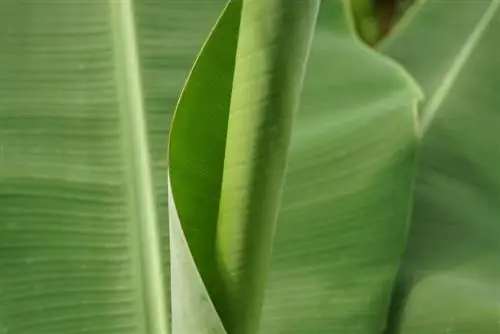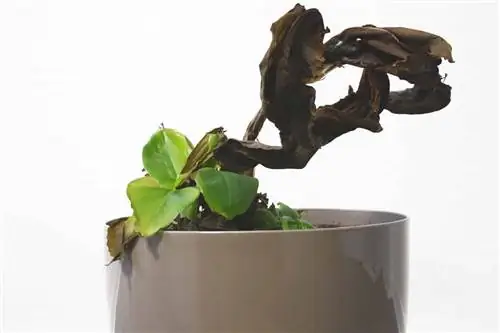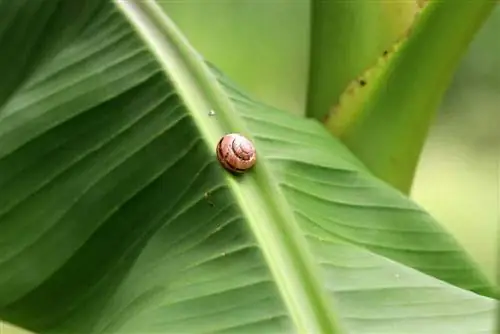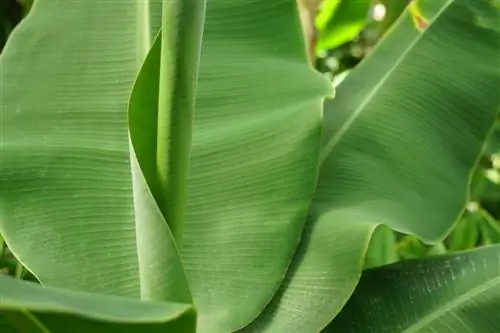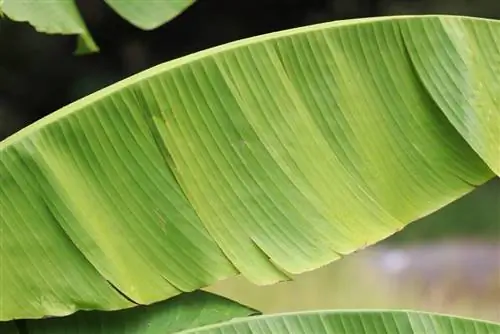- Author admin [email protected].
- Public 2023-12-17 03:39.
- Last modified 2025-06-01 06:48.
If it feels comfortable, it can grow to quite large sizes and with a lot of luck it will start to bloom and even develop fruit. In our latitudes, the banana tree is usually grown as a container plant. However, recently there have been more and more specimens planted out in the garden. Both variants are possible depending on the species, but regardless of whether in a pot or outdoors, they must be wintered correctly so that you can enjoy them for a long time.
Pay attention to the needs of different species
Since each species has special needs, it is good to find out about the exact variety name when purchasing. Basically, banana trees can be divided into three large groups:
- temperate zone - conditionally hardy: the plant can overwinter outdoors with frost protection
- tropical zone - not hardy: the plant can be overwintered in the basement at around +10 degrees
- subtropical zone - by no means hardy: these plants need uniformly warm temperatures all year round.
Overwintering a hardy banana tree
The easiest way to get your banana tree planted in the garden to survive the winter is to saw the trunk just above the ground. Cover everything with leaves and straw or Styrofoam and finally put a tarpaulin over it. It is important that the rest of the trunk is protected from frost as much as possible. In spring everything is removed and the plant sprouts again. The disadvantage of this method, however, is that the perennial will not grow large as quickly and will not bear fruit.
If you want to prevent this, you should cut the trunk back to waist height before the start of winter. A cylinder is then built around the trunk at some distance. This can be made of Styrofoam or fine-mesh wire mesh. Now the resulting space is filled with straw or leaves. Mulch fabric is now stretched over this construction. Condensation from the inside should be able to escape to prevent rot and rainwater from the outside should be able to drain off just as easily.
Getting the tropical banana tree through the winter well
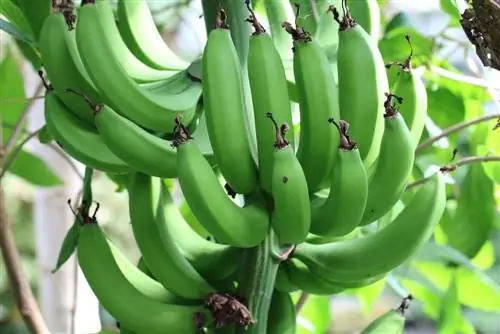
In order to get the tropical species through the cold season optimally, overwintering in the cellar is a good idea. As soon as the temperature drops to around 5 degrees, the banana trees should be moved to winter quarters. Whether you shorten the leaves significantly or leave them as they are depends on the space available. The plants should then be kept as dry as possible. The surface of the soil can dry out and watering should be sporadic during the winter months. A tuber that is too wet can quickly rot. Light can be dispensed with during the time in winter storage.
The wintering of the subtropical species
The banana tree, which comes from subtropical regions, wants a temperature of around 18 degrees even in winter. If the plant gets too warm, there is a risk that spider mites will nest on it. It should therefore be monitored continuously. Despite a warm winter, it needs a rest period during which it should be watered less. It's best to only water when the soil comes away from the edge of the pot.
Tips for hobby gardeners
- The trunks of banana trees are usually not woody, but are very thick and fibrous. A small saw is suitable for cutting.
- Cutted parts of the banana can be easily composted. They should be chopped well beforehand.
- Well-preserved banana leaves can be used in the kitchen. They are ideal for grilling to keep meat juicy and give it a special taste. The banana leaves can also be frozen.
- A large banana tree can be hibernated at an angle if space is limited. Secure the pot well and support the trunk.
- After overwintering, some of the leaves may have turned yellow or brown. You can remove these, but this is a purely visual problem.
Consequences of incorrect wintering
If a plant of the hardy or tropical variety is overwintered too warmly, it will not begin to sprout properly in spring. Growth is slowed and the natural cycle is disrupted. This can be remedied by watering sparingly and, if possible, in a shady spot. When growth begins in summer, water more. After a correct overwintering, the plant should have found its rhythm again the following year. Something similar happens if a subtropical banana species overwinteres too coolly. It stops growing for months.
If a banana tree is properly overwintered, it will begin to grow immediately in the spring, produce offshoots in the summer and, if you're lucky, even flowers and fruits after the 3rd year, thus certainly providing a lot of joy.
Take light and heat requirements into consideration
The banana tree loves light in the room. It needs a lot of light, so a window seat is ideal. Since it is always warm in the tropics, it is not absolutely necessary to change the location in winter, you just have to ensure there is enough light. If this is not possible due to the given circumstances, special commercial plant spotlights have proven to be effective. It is important - and not just in winter - that the climate in the room is not too dry.
On the other hand, you can also let the banana tree overwinter in a cool atmosphere. You should do this especially if you want to harvest fruit the following year. Then the winter break is extremely important for the banana tree to recharge its batteries.
Use rainwater, take protective precautions
If you give your banana tree a winter break, the temperatures are ideally around 15 degrees Celsius. Only a little should be watered. By the way, it is best to always use rainwater to water a banana tree because of the low lime content.
If you have your banana tree outdoors, you should also take precautions for the winter. Banana trees are not hardy, but despite everything, with appropriate protective measures, they can easily tolerate the winter cold in our latitudes.
So that the roots of the banana tree are not damaged, the ground should be avoided from freezing. This is best achieved by generously covering it with humus or something similar. The trunk is well protected with a casing made of cane or bamboo. The crown is covered with foil or a jute bag, which must be transparent because of the brightness required. Greatest attention should be paid to protecting the roots. Frozen leaves are not a problem.

